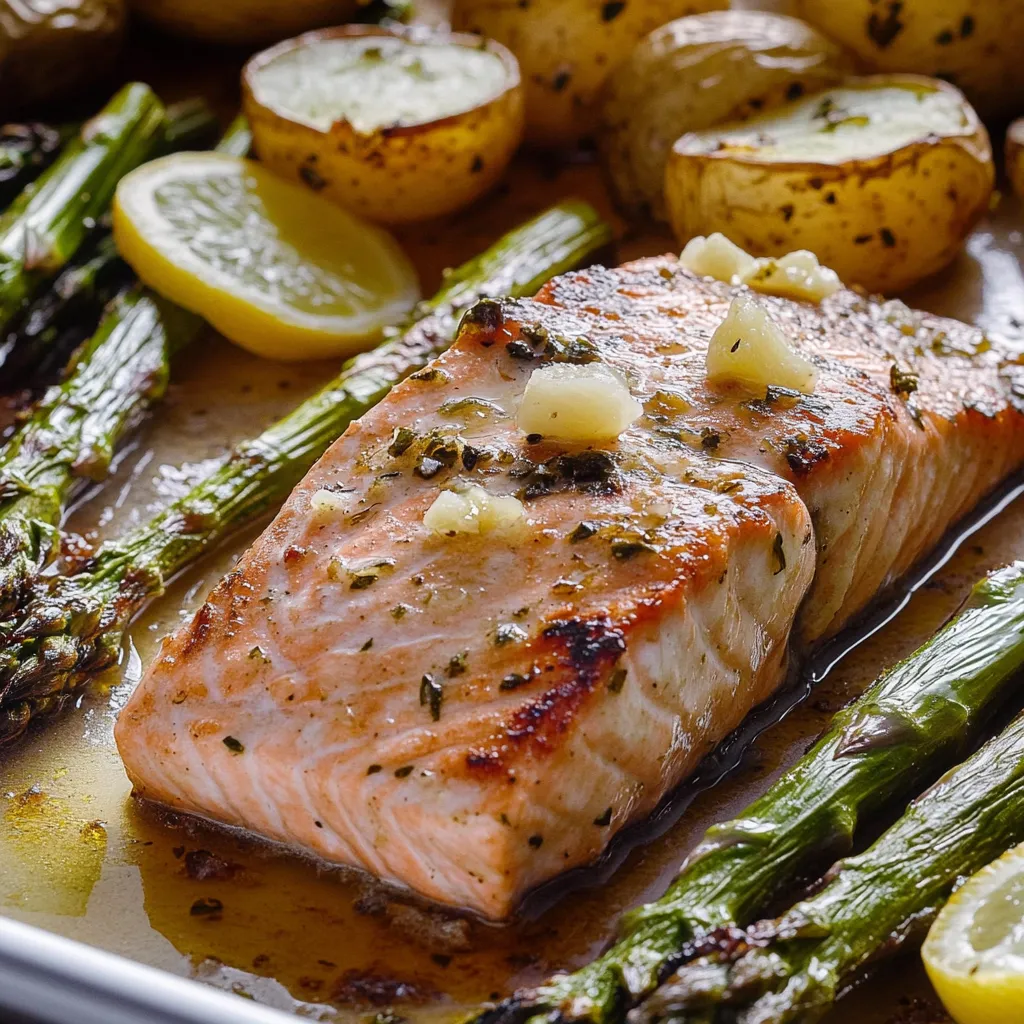 Save
Save
Pan-seared salmon with buttery garlic sauce brings fancy restaurant vibes to your home without the fuss. This no-hassle meal combines juicy salmon, crunchy spuds, and green asparagus all drizzled with a delicious garlicky butter that soaks into every bite, turning basic ingredients into something you won't forget.
I stumbled on this dish during a crazy busy week when I needed something that looked fancy but wasn't complicated. My husband took a bite and stopped talking mid-sentence to ask, "When did you find time to cook this?" I've kept how easy it is a secret until now—sometimes it's nice when folks think you slaved away in the kitchen!
Taste-Boosting Components
- Salmon chunks create the ideal base for soaking up all these amazing flavors—grab wild-caught for better taste if you can
- Small potatoes give you that wonderful mix of crispy outsides and soft insides—their tiny size means they finish cooking right when the salmon does
- Real garlic adds intense flavor that powder just can't deliver—don't hold back, it gets much milder when baked
- Butter makes everything taste incredible—go for unsalted so you can add just the right amount of salt
- Lemon adds a zingy kick that cuts through the richness—always go with fresh squeezed
- A splash of white wine deepens the sauce—even a tiny bit makes everything taste more fancy
 Save
Save
Simple Cooking Steps
Potato Prep FirstStart by heating your oven to 400°F, then mix your cut baby potatoes with olive oil, some of your chopped garlic, salt and pepper. Put them flat on your baking sheet and let them cook for 15 minutes alone. This gets them nice and golden outside while making sure they turn soft inside.
Fish PlacementWhen the potatoes have cooked a bit, push them to one edge of the pan. Put your salmon pieces skin-down in the middle to be the main attraction. Rub them with chopped garlic and fresh parsley, making sure to cover every bit. This puts those flavors right into the fish from the start.
Green Veggie TimePut your cleaned asparagus on the other empty side of the pan. This smart layout makes sure everything cooks right while letting the flavors mix together. The asparagus will cook just enough to stay slightly crunchy while the salmon finishes.
Buttery DrizzleMix melted butter with fresh lemon juice and pour this tasty mixture over your salmon and asparagus. This easy combo works wonders by keeping the fish moist and creating a natural basting sauce as it cooks. Finish with a sprinkle of salt and some black pepper.
Last Cooking StepPut your pan back in the oven for about 10 minutes, until the salmon turns light pink and breaks apart easily with a fork. For extra crispy bits, switch to the broiler for the last two minutes—just keep an eye on it to catch that perfect moment when the edges turn golden and slightly crispy.
I once cooked this for my mother-in-law who always says she "doesn't really like salmon." After we ate, I caught her secretly wiping up the last bits of garlic butter from the pan with her finger. She's asked me to make it three more times, though she still claims she's "not big on fish." Seems garlic butter can win over even the biggest salmon skeptics!
What To Serve With It
This dish is pretty much a full meal on its own, but a cool glass of the same white wine you cooked with makes everything taste even better together. For fancy dinners, start with a basic green salad with lemon dressing, and maybe finish with something light like fresh berries and whipped cream to balance out the rich main course.
Mix It Up
Try swapping the asparagus for broccolini or string beans—both hold up great when roasted and soak up that garlic butter nicely. For different flavors, toss some fresh dill or thyme into your butter mixture. When oranges are in season, use orange juice instead of lemon for a sweeter, more fragrant sauce that goes really well with the fatty salmon.
Saving Extras
Keep any leftover fish apart from the veggies in sealed containers in your fridge for up to two days. Warm the salmon gently in a low-temp oven (around 275°F) just until it's heated through so it doesn't dry out. The vegetables can handle higher heat and will get crispy again under the broiler for a minute or two.
 Save
Save
Useful Cooking Tricks
- Wipe your salmon pieces dry before adding seasonings so they stick better and edges get crispier
- Chop potatoes to the same size so they all finish cooking at the same time
- For thicker asparagus, try peeling the bottom parts to make them more tender
My grandpa was a fisherman who always told me the simplest cooking methods show off fresh fish the best. He'd probably raise an eyebrow at anything fancier than butter and lemon on his catch, but I think he'd enjoy this dish. The garlic and herbs boost rather than hide the salmon's natural goodness, making something that respects good ingredients while making them taste even better. Whenever I cook this, I remember him and how he taught me that great food doesn't need to be complicated.
Recipe FAQs
- → Can frozen salmon be used?
- Go ahead, just make sure to thaw it fully and pat dry before cooking. Add a little extra time in the oven if needed.
- → What’s a good asparagus substitute?
- Try swapping in broccoli, green beans, or Brussels sprouts. Tougher veggies should bake alongside the potatoes.
- → Skinless salmon only?
- Nope, skin-on works too! Lay it skin-side down while baking. The skin keeps it from overcooking and is easy to remove later.
- → Can this be prepped early?
- Absolutely! Chop veggies ahead of time. Store potatoes in cold water in the fridge to keep them fresh.
- → How do I know salmon’s cooked?
- It’s ready when a fork can flake it apart easily and it’s no longer raw in the center. A slightly translucent core means medium-cooked.
- → Can dried parsley replace fresh?
- Of course! Use 2 teaspoons dried instead of 2 tablespoons fresh since dried herbs are stronger in flavor.
